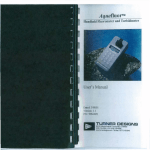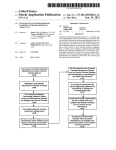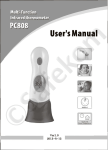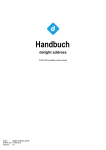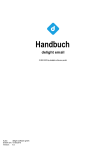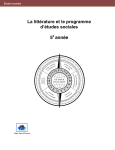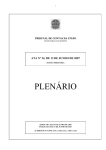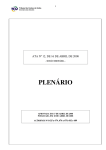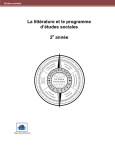Download 220w Xyz
Transcript
US 20060248540A1
(19) United States
(12) Patent Application Publication (10) Pub. No.: US 2006/0248540 A1
(43) Pub. Date:
Sterner et al.
(54)
AUTOMATIC SOURCE CODE GENERATION
(76) Inventors: Peter Sterner, Waldbronn (DE); Klaus
Prasse, Karlsruhe (DE); Herbert
NOV. 2, 2006
Publication Classi?cation
(51)
Anderer, Waldbronn (DE)
(52)
Int. Cl.
G06F 9/46
G06F 9/44
(2006.01)
(2006.01)
Us. or. ............................................................ ..719/321
Correspondence Address:
PERMAN & GREEN
425 POST ROAD
(57)
ABSTRACT
FAIRFIELD, CT 06824 (US)
(21) Appl. No.:
11/384,974
(22) Filed:
Mar. 20, 2006
(30)
A data processing device comprising a ?rst generation unit
for generating, based on generic data de?ning a functional
interface of an apparatus in general terms, a formalized
description of the functional interface of the apparatus, and
Foreign Application Priority Data
Apr. 14, 2005
(EP) ................................. .. EP05102938.7
a second generation unit for generating, based on the for
maliZed description, source code for realizing the functional
interface of the apparatus.
200
21 0w
220w
lnst.xml
Header
N230
240w
Xyz-h
~240
250
Document
xx.html
xx.pdf
xx.doc
Patent Application Publication Nov. 2, 2006 Sheet 1 0f 6
US 2006/0248540 A1
/
100
106
S
108w
/2oo
210w
220w
lnst.xml
2
Header
~230
240w
xyz-h
~24o
25o
Document
“'htm'
xx.pdf
xx.doc
Patent Application Publication Nov. 2, 2006 Sheet 2 0f 6
US 2006/0248540 A1
300
304
DCIUDDDDUDDDUDD
DUDUDUDDCJDDDDU
DUUDUDDEIDDUDDDD
DEJDSDDD
W
D
CID
DEI
'
0k
Patent Application Publication Nov. 2, 2006 Sheet 3 0f 6
US 2006/0248540 A1
/
500
[command properties
(Main IDependeneyI name docul description docul default values dooul examples docu] Reply CodesI Varianlsl Parameler'
Vendor
lAgilent Technologies, Inc.
N ame
CIII 5 “i ': H E
Classification
[IE
symbolic Tokenname
ITUK_CD5Y_NEW
5|
_
50 1
g
1
Category
I
I [Command
'
Ill
send lo process Q Q
direct Tolab Handler o
J OK
Fig. 5
Cancel
|
Apply
502
Fig. 6
l
[600
command propenies
A]
[ Main | Dependency] name docu [description doeu [default values docul examples docul Reply Codes] Variants] Parameter]
- documenlalion
dMUrnm-‘t
This instruction create a new, emply BUSY-List. If lhe list already exist it will
be delelet before a new empty one will be created.
text
Classification
601
601
601
DocType
\
'
K
/
‘
newLine
Format
601
OK
602
Cancel
Apply
1
Patent Application Publication Nov. 2, 2006 Sheet 4 0f 6
/
US 2006/0248540 A1
700
[command propenies
33
{Main I Dependenqi name docul description docul deiault values docu] examples docu [Reply Codes IVarianls I Parameler'
FleplyCodes
791
content
f
Documentation
Ina error, inslrucliun has been accepted /
H
Symbolic name
|
I
Classificalion
|
)
, OK
Fig. 7
apply
I
m
Fig. 8
[800
Ellgllent - Ml - You!
FIB
Cancel
MLxml
.‘?éj
Eli M
>
‘ properties
‘
2E1
lAg‘lu-u rMain I DepmdencyI mnmdowI desublionduwI dcleullvolue: rheul exarnalesdnw] ?ew?odcsl Vaimlsl Paameker
YzNEW
L.‘
Active c
-
‘
.
mul hstInL 32k_32k
‘E
I:
"M
M
[II
- code w=~i=~
lCCISYzNEW (‘mu li:l:lnk_-32k_32k>
I
\
\
I
I
HEQH
We’_
edit parameter
'
Ll
J
801
v
mm
|_T(_|
@
)
L—- var COSYISND
cmd COSYzSIDP
and
1- FnQY-RTFII
var CDSYSTUP
‘dIl-ell
'
Patent Application Publication Nov. 2, 2006 Sheet 5 0f 6
US 2006/0248540 A1
/
900
[Elkgilam - XML Pmlaci - Mlcrosn? Inlemnl Elplruur provided by Agllunt Technologins. Inc.
P.
Agilem Technologies
common pan
haseTynu
m
events
group: COSYCmd
group documentation:
COSY i: a general mzchmixm implemented to realize module inbcmal and module ovcriapping system coma) and
:ynchronizau'cn The min components ofCOSY we list: and aniuterprele! In process the Em. A COSY-Ust is a :equence
of COSY-Element: each at’ which is a ?mc?onal unit. COSY-Hemems can be classi?ed into three cmgcries: Hemerns for
:ymh'onindon, for command: md to execute a kin-union.
tonnvrs of rmnmknds
rnnslsrs of poupx
Emma“,
Agillm-XML Project-Mlcruso?
Flvwtn
"
r'
r
{ads the
Ll psohm"
COSYtNEW
COSYzNEW
SurlignlR-hinnlmu?im“
StnrliglLI. ampPnmmeters
Paramelerl-[andler
Aumman'un
Limit
Name
COS YZNEW
Creme COSY-Usu M a cosY-un.
Synopsis
COSYtN'EW <Iimul El?n! {A 2% :>
Dumpnnn
This iruwe?on cum a new. empty {(JOSY-Liuv Iflhe in already en'nh will be were! before I new singly on: will be
:re med.
Reply (Indra
M 00000
no error. inmmlion has been accepted
gommgn Regk'Qed-el
Example.‘
Ill
‘
Nov. 2, 2006
US 2006/0248540 A1
AUTOMATIC SOURCE CODE GENERATION
BACKGROUND ART
[0001]
The present invention relates to automatic source
code generation.
[0002]
When a neW laboratory apparatus, for instance a
?uid separation system or a biochemical analysis device, is
being developed, source code has to be developed by a
human programmer. After a compilation of the source code,
[0009] Embodiments can be partly or entirely embodied or
supported by one or more suitable softWare programs, Which
can be stored on or otherWise provided by any kind of data
carrier, and Which might be executed in or by any suitable
data processing unit. The data processing scheme can be
realized by a computer program, i.e. by softWare, or by using
one or more special electronic optimization circuits, i.e. in
hardWare, or in hybrid form, i.e. using softWare components
and hardWare components.
and controlling the functionality of the apparatus. Apart
[0010] One exemplary aspect of embodiment can be seen
in the fact that, for assisting in the development of an
apparatus like a laboratory apparatus, it is su?icient that a
from this, a user manual is Written describing the function
human being inputs generic data de?ning the functionality
ality and the instruction interface of the apparatus. With the
of the apparatus, particularly de?ning a functional interface
of the apparatus, to be designed in general terms, that is to
it can be executed in the developed apparatus for providing
help of such a user manual, a human user is enabled to
operate the apparatus or to adjust the apparatus to her or his
say in a verbal but in some sense formalized manner
preferences.
according to a syntax understandable for a human being or
DISCLOSURE
[0003]
It is an object of the invention to provide an
improved data processing. The object may be solved by the
independent claims. Exemplary embodiments are shoWn by
the dependent claims.
[0004] According to an exemplary embodiment of the
present invention, a data processing device is provided
comprising a ?rst generation unit for generating, based on
generic data de?ning a functional interface (or a function
ality) of an apparatus in general terms, a formalized descrip
tion of the functional interface (or the functionality) of the
apparatus, and a second generation unit for generating,
close to a human language. The data processing system
according to an embodiment may then automatically gen
erate a (more or further) formalized description of the
functionality of this apparatus. This formalized description
may be a formulation of the desired functionality of the
apparatus and may provide instructions in a symbolic logic
to be readable by a machine to be a proper basis for
generating source code for realizing the functionality of the
apparatus. Such automatically generated source code, after
being compiled, may be executed in the apparatus to be
developed and may then serve to control or provide the
functionality of the apparatus.
[0011] According to one aspect of embodiments, a tool for
automated creation of source code and/or corresponding
based on the formalized description, source code for real
documentation from a formalized lab device interface
izing the functional interface (or the functionality) of the
description may be provided.
apparatus. Optionally, a third generation unit may be pro
vided for generating interface documentation out of the
[0012] According to an aspect of embodiments the, the
formalized description.
[0005] According to another exemplary embodiment, an
apparatus for providing a functional interface (or a func
tionality) is provided, Wherein the apparatus comprises a
formalized description of the functional interface (or the
functionality), and Wherein the formalized description is
generated based on generic data de?ning the functional
interface (or the functionality) of the apparatus in general
terms.
generated source code may de?ne the interface of the
apparatus to be developed, that is to say all functions of the
apparatus Which may be accessed via the functional inter
face.
[0013]
In other Words, When developing a neW apparatus,
it is made possible by the data processing scheme according
to an embodiment that an engineer just de?nes an entire set
of functions of the apparatus (e.g. commands, events,
parameters, etc.) accessible via a functional interface in a
language according to a unique syntax relatively close to a
[0006] According to still another exemplary embodiment,
human language With Which the engineer is familiar, for
a method of processing data is provided, the method com
instance via a GUI (graphical user interface) based template
prising generating, based on generic data de?ning a func
tional interface (or a functionality) of an apparatus in general
on a computer monitor. The system according to an embodi
ment is then capable to translate or transfer this code in a
more formalized representation. Such a more formalized
terms, a formalized description of the functional interface
functional interface (or the functionality) of the apparatus.
representation can be, for instance, XML (Extensible
Markup Language). This code may be independent from a
special kind of language used by the human user.
[0007] According to yet another exemplary embodiment,
[0014]
(or the functionality) of the apparatus, and generating, based
on the formalized description, source code for realizing the
a computer-readable medium is provided, in Which a com
puter program of processing data is stored, Which computer
program, When being executed by a processor, is adapted to
control or carry out the above-mentioned method.
[0008] According to still another exemplary embodiment,
a program element of processing data is provided, Which
program element, When being executed by a processor, is
adapted to control or carry out the above-mentioned method.
Such a formalized description, for instance in the
form of an XML ?le, may then be used according to an
embodiment for generating computer-readable program
source code Which is, after compilation and When being
executed by a processor, capable of realizing the entire
functional interface of the apparatus to then readily devel
oped. Thus, source code may be generated in accordance
With the generic data and may be generated automatically
after having speci?ed the desired functionality in general
terms. Consequently, a programmer never has to touch the
Nov. 2, 2006
US 2006/0248540 A1
automatically generated source code, Which in turn elimi
nates the problem that implementation and documentation
external device. This XML-?le provides a formal descrip
tion of all functions, Which may be realized With the
may differ. The described scheme according to an embodi
apparatus.
ment may thus alloW designing any apparatus, for instance
a laboratory apparatus, in a signi?cantly simpli?ed manner,
faster and cheaper. Generated source code may be imple
mented in the apparatus Without the necessity that a human
programmer has to revieW the code.
[0015]
In a scenario in Which only one or some particular
functions of an already developed apparatus shall be modi
?ed for developing a similar but functionally modi?ed
apparatus, it is easily possible to just “reload” the interface
description in the formalized language to the data processing
[0020] A developer may simply specify Which functions
an apparatus to be designed shall provide. This group of
functions may then be transferred in a formalized descrip
tion like an XML-?le, particularly in an automatic manner.
From this formalized description, a header for ?rmWare, that
is to say compilable source code, may be generated Which
may include all information necessary for the interface of
the apparatus to be designed. For generating the source code,
the system may optionally access a program library con
taining particularly standard routines, Which may be used by
device according to an embodiment so that it is not neces
the machine to generate source code in a short time.
sary to program everything again from the very beginning.
[0021] Optionally, the formalized description may not
It may be suf?cient to selectively modify one or more
parameters related to a function to be modi?ed. Then, it may
be sufficient to just press some kind of “Generate Code”
button on a screen or a keypad to instruct the system to
generate the updated or modi?ed source code. Moreover,
retro?tting of particular functions to an already existing
apparatus can be performed easily.
[0016] The term “generic data de?ning a functionality of
an apparatus in general terms” may particularly denote the
opportunity to provide the system With data in a language in
Which the desired functionality may be articulated by a
human being. Thus, the information de?ning the desired
functionality can be Verbalized in a manner With Which a
human user is familiar. For instance, such generic data
de?ning the functionality of an apparatus in general terms
may be “the device shall include a command Which initiates
the mixing of a ?rst liquid having a ?rst concentration With
only be used as a basis for generating the source code, but
may also be used as a basis for generating a documentation
or manual for a user, for instance as an HTML ?le, a Word
?le or an PDF ?le.
[0022] Thus, it may be prevented that the documentation
of a device’s instruction interface and its actual implemen
tation dilfer. The developer (for good reasons) often changes
some instructions or parameters but forgets to consistently
update the documentation. This results in incompatibilities
With controlling softWare and confusion for the user. Such
incompatibilities may be securely avoided by the described
aspect.
[0023]
Since it may be made possible according to
embodiments, from one and the same formalized description
and in an automatic manner, source code on the one hand
and a documentation readable by a human user on the other
a second liquid having a second concentration”. This non
hand, it may be guaranteed that the documentation delivered
formalized description may be input by a user via a given
data input structure. For instance, this information may be
input in a structured manner via a mask With data input ?elds
in Which the different pieces of information are insertable by
to a customer coincides With the functionality actually
a human user. This can, for instance, be realized With a
graphical user interface on Which computer WindoWs are
visualized alloWing a user to input the generic data. In other
Words, a system according to an embodiment may provide
a user With a communication interface Which may alloW the
user to enter the data Without the necessity that the user cares
about the question if the input data can be read by a machine.
[0017] The input ?elds of such a generic data inputting
tool may then be coupled, combined or linked according to
a complex data connection structure (Which is usually invis
ible for a human user) Which may process the data in a
manner as to generate a code Which is a formalized descrip
tion.
[0018] The term “formalized description” may particu
larly denote a description in a language Which can be read
or interpreted by a machine or an algorithm Without the
interference of human intelligence. The formalized or logi
cal description may be any program code encoding the
functionality of the apparatus in a format that needs not to
be understood by a human being.
[0019] According to an exemplary embodiment, the for
malized description of the functionality (for instance in the
form of an XML-?le) can be stored in the produced appa
ratus, Wherein it may be possible to be accessed from an
provided by the apparatus. In other Words, documentation
and source code are conform With high reliability.
[0024] Further, it may be dispensible that a developer has
to manually Write a documentation. Instead of this, the
documentation may be generated automatically, since all
information required for this purpose is derivable from the
generic data and thus also from the formalized description.
Therefore, a perfect conformity betWeen documentation and
source code may be achieved.
[0025] According to an exemplary embodiment, it may be
possible to generate at least tWo different documentation
?les according to at least one predetermined parameter. For
instance, a documentation generated for a customer may be
different from a documentation generated for the employees
of a company developing the apparatus. For example, a
documentation accessible for the employees of the company
developing the apparatus may contain con?dential informa
tion Which may not be accessible in the documentation for
the customers. Thus, any item of the input generic informa
tion may be assigned With a ?ag or the like indicating that
a particular piece of information may be con?dential. HoW
ever, distinguishing betWeen con?dential and non-con?den
tial data is not the only possible criteria for deciding Which
information should be included in Which type of documen
tation. Another exemplary criteria for distinguishing Which
information should be included in Which type of documen
tation is the importance of a particular piece of information.
Thus, it may be possible to generate a brief summary
Nov. 2, 2006
US 2006/0248540 A1
documentation of the functionality including only informa
tion classi?ed as particularly important, and to generate a
detailed documentation of the entire functionality including
all information regardless its importance.
[0026] Furthermore, When extending or modifying the
functionality of an apparatus to be designed, it may be no
more required to revieW and reWrite the entire documenta
tion again, but it may be suf?cient that the generic data or the
describing many different kinds of data. A purpose is to
facilitate the sharing of structured text and information.
Languages based on XML (for example RDF, RSS,
MathML, XSIL and SVG) are themselves described in a
formal Way, alloWing programs to modify and validate
documents in these languages Without prior knoWledge of
their form.
formalized description is only punctiformly modi?ed. Then,
[0032] Such an XML ?le may be processed using a
Stylesheet. A Stylesheet may be used in order to separate the
a “Generate” button may be pressed for generating both
form of a description from the content of a structured
modi?ed documentation and modi?ed source code.
document (for instance XML). Stylesheets may alloW to
[0027] Thus, the functionality of the apparatus to be
interpret contents in dependence of an output device. For
this purpose, the content does not have to be changed.
designed may be extendable in a simple manner, and it may
be ensured that an automatically generated manual ?ts to the
speci?cation of the device according to the source code.
[0028] Thus, according to one aspect of embodiments, a
set of commands for an apparatus to be developed (e.g.
functions, parameters, events) may be de?ned by a devel
oper and described in a colloquial language or common
speech. From this generic data formulated in general terms,
Examples for Stylesheet languages are CSS, XSL and
DSSSL. Source code readable by a computer may be gen
erated based on the XML ?le. Such a source code may be,
for instance, C++ code.
[0033] Furthermore, a Stylesheet may be used in combi
nation With the XML ?le to automatically generate the
manual Which may be directly readable by a human user.
a formalized description of the desired set of commands may
Such a documentation may be a HTML ?le or a PDF ?le.
be generated, for instance in XML, using a data connection
structure for processing and evaluating the different generic
[0034] In this speci?cation, the term “functionality” may
data items. From this formalized description, source code for
?rmWare may be generated. Simultaneously, the formalized
description can be used as a basis for generating a user
manual in an automated manner. Thus, discrepancies
betWeen documentation and control code may be securely
avoided. The term “common speech” may particularly
denote a language Which is in some sense formal (since it
may be restricted by particular rules), but Which may still be
understood by a (skilled) human user. Further, the term
“common speech” may particularly denote an unambiguous
syntax Which is close to human speech.
[0029]
An example for a command Which may be input as
generic data is “COMP [% B], [% C], [% D]”. “COMP” may
a keyWord for a particular function. The three items “[% B]”,
“[% C]”, and “[% D]” may be parameters for specifying the
function in more detail. The keyWord COMP may de?ne the
functionality of a pump for treating four liquid components
A, B, C, D Which shall be mixed according to preset
percentages % B, % C, % D, Wherein the percentage of
component A results from the frame condition that the sum
of A, B, C, and D should be 100%. Based on such generic
data like “COMP [% B], [% C], [% D]”, corresponding
source code may be generated automatically, Which can be
executed by the apparatus to be developed. Another example
for a piece of functionality to be de?ned in a common speech
is “EV 0560”. This may de?ne that the apparatus to be
designed provides as an output that a particular event has
happened, for instance “Analysis Completed” When an
entire analysis procedure has been carried out successfully.
[0030] For instance, by simply pressing a button, the data
structure input by the human user may be connected and
processed automatically so that an XML ?le Will be gener
ated. The translation into the XML ?le may be performed by
a particular softWare element. This softWare element con
particularly denote one or more functional items Which an
apparatus to be de?ned may service or provide, or an
instruction repertoire. It may also denote the entirety of all
functions Which the apparatus o?‘ers. “Functionality” may
include commands Which the apparatus understands and
Which the apparatus may carry out. “Functionality” may
include actions Which the apparatus may perform by itself,
Without external control or trigger, for instance the indica
tion of a particular operation state.
[0035] In the folloWing, further exemplary embodiments
of the data processing device Will be described. HoWever,
these embodiments also apply for the apparatus for provid
ing a functionality, for the method of processing data, for the
computer-readable medium and for the program element.
[0036] The “generic data” may de?ne the functionality of
the apparatus in a language understandable by a human
being. In contrast to this, such generic data may be incom
prehensible for a machine like a computer. The generic data
may be input in plaintext or clear text in a manner Which is
close to a human articulation. By structuring input ?elds of
the receiving unit in order to enable a human user to input
information in human language, but already pre-structured,
it is possible to communicate With a human developer and to
simultaneously cause the human developer to enter the data
according to a given order. Thus, the receiving unit may
alloW a communication in general terms With the human
being, but may set the course for a subsequent translation of
the instructions into a machine language, similar like a form
or a questionnaire.
[0037] Furthermore, the “formalized description” may
de?ne the functionality of the apparatus in a language
interpretable, compilable or understandable by a machine.
Thus, the data processing device may abstract and/or for
nects the different items of plaintext. In other Words, the data
related to the input ?elds in the user interface may be linked
malize the generic data to reformulate it in a machine
in such a manner that the XML ?le or any other formalized
[0038] The data processing device may comprise a third
generation unit for generating, based on the formalized
description, a user manual documenting the functionality of
the apparatus. Such a manual can be generated automatically
description is automatically generated.
[0031] The Extensible Markup Language @(ML) may be
considered as a simpli?ed subset of SGML, capable of
readable manner.
Nov. 2, 2006
US 2006/0248540 A1
from the formalized description including all required infor
[0044] The second generation unit may be adapted to
mation so that it may be dispensible that a detailed user
manual has to be Written manually by a human in a cum
generate source code readable by a parser of the apparatus.
A parser may particularly denote a program or a physical
bersome manner. Furthermore, consistence betWeen docu
entity Which is capable to decide Whether an input data set
is compatible With the grammar of a particular language.
Parsing may include a syntactic check of the input data set.
Thus, the source code may be read by the parser of the
mentation and actually implemented functionality, re?ected
by the source code, may be achieved.
[0039] The third generation unit of the data processing
device may be adapted to generate the user manual in a
apparatus.
manner to be displayable and/or to be printable. Thus, the
[0045] The second generation unit may be adapted to
user manual may be displayed on a display device of a
generate the source code using a Stylesheet.
graphical user interface (GUI), for instance in the form of an
HTML ?le comprising a plurality of linked pages. A user
may use an input tools like a computer mouse to click
through the pages, or may electronically search the docu
mentation ?le to rapidly ?nd a subject of interest. The
documentation may also be provided in a form that it can be
printed as a hard copy using a printer device. For this
purpose, it may be appropriate to generate the documenta
tion as a PDF ?le or as a Word ?le.
[0040]
The data processing device may comprise a receiv
ing unit for receiving the generic data de?ning the function
ality of the apparatus. The receiving unit may be a user
interface via Which a user may input the generic data.
Particularly, such a receiving unit may include a Graphical
User Interface (GUI) via Which a human user may input
data. Such a graphical user interface may include a display
device (like a cathode ray tube, a liquid crystal display, a
plasma display device or the like) for displaying information
to a human operator, like masks in the form of WindoWs in
Which input ?elds may be provided. Such a graphical user
interface may further comprise an input device alloWing a
user to input speci?cation data or to provide the system With
control commands. Such an input device may include a
keypad, a joystick, a trackball, or may even include a
microphone of a voice recognition system. The GUI may
[0046] Furthermore, the second generation unit may be
adapted to generate the source code in any appropriate
program language, Which may be object-oriented or not.
Exemplary possible program languages are C, C++, C#,
Pascal, Basic, For‘tran, or Java.
[0047] The data processing device may be adapted in such
a manner that the apparatus to be designed may be at least
one of the group of a measurement device for performing a
measurement in a coupled or connected measurement envi
ronment, a sensor device, a test device for testing a device
under test, a device for chemical, biological and/or pharma
ceutical analysis, a ?uid separation system adapted for
separating components of a ?uid, and a liquid chromatog
raphy device. HoWever, these ?elds are only exemplary, and
the development of any other apparatus realiZing a speci?ed
functionality is possible as Well.
[0048] Thus, the apparatus can be a measurement device
Which may perform any kind of measurement.
[0049]
The apparatus can also be any kind of sensor
sensing any physical, chemical or other parameter like
temperature, humidity, pressure.
[0050]
Further, the apparatus can be realiZed as a test
device for testing a device under test (DUT). For testing
alloW a human user to communicate With the system in a
electronic devices, in particular integrated electronic circuits
bidirectional manner.
providing digital electronic output signals, a test or stimulus
signal may be fed to an input of the DUT, and a response
signal of the DUT may be evaluated by an automatic test
[0041] Furthermore, the receiving unit may be adapted to
receive the generic data de?ning a complete functionality of
the apparatus. In other Words, an entire, completingly
de?ned functionality may be speci?ed via the receiving unit
so that a virtual development of a device is possible. The
realiZation of the softWare for controlling such an apparatus
may be generated in a computer-based manner from the
input speci?cation. Thus, an apparatus construction set may
be provided according to an embodiment.
[0042] The receiving unit may be adapted to receive an
entirety of all commands executable by the apparatus and/or
an entirety of all actions perforrnable by the apparatus. Such
a command may alloW a user of the apparatus to access or
call a particular function Which is intended to be carried out.
An event may denote an action Which may be performed
automatically by the apparatus in the presence of a particular
scenario.
equipment, for example by comparison With expected data.
[0051]
In a realiZation of the apparatus as a device for
chemical, biological and/or pharmaceutical analysis, func
tions like (protein) puri?cation, electrophoresis investiga
tion of solutions, or chromatography investigations may be
realiZed by the analysis device.
[0052] According to another exemplary embodiment, the
apparatus to be designed may be a ?uid separation system
adapted for separating compounds of a ?uid. Such a ?uid
separation system may comprise a ?uid delivering unit
adapted for delivering ?uid, a separation unit adapted for
separating compounds of the ?uid and to provide at least one
separated component.
[0053] According to another exemplary embodiment, the
data processing device may comprise a storage unit for
[0043] The ?rst generation unit of the data processing
storing the generic data (for instance received by the receiv
device may be adapted to generate, based on the generic
data, an Extensible Markup Language ?le as the formalized
ing unit), and may comprise a modi?cation unit alloWing to
modify the generic data stored in the storage unit to modify
description of the functionality of the apparatus. HoWever,
the functionality of the apparatus. In other Words, a set of
using an XML ?le is only an example for an appropriate
formalized description language, any other suitable formal
generic data Which has been input before (for instance in the
frame of the development of another apparatus) can be
iZed description or programming language may be used as
Well.
reloaded in the user interface, and a selective modi?cation of
individual functions may be carried out. This may alloW to
Nov. 2, 2006
US 2006/0248540 A1
generate source code and/or a user manual in a simple
manner Without the necessity to start developing the appa
ratus from the very beginning.
[0054] In the following, exemplary embodiments of the
apparatus for providing a functionality Will be described.
However, these embodiments also apply for the data pro
cessing device, for the method of processing data, for the
computer-readable medium and for the program element.
[0055] Particularly, the apparatus may comprise an inter
face via Which the formalized description of the function
ality of the apparatus is providable to an entity connected to
the interface. Thus, the formalized description (for instance
formulated in accordance With a particular industrial stan
or linked WindoWs to alloW to enter the input data in the
input data ?elds in an intuitive manner.
[0065] The data processing device 100 further comprises
a central processing unit (CPU) 105 Which receives the
generic data entered via the graphical user interface 101 and
Which is capable for generating, based on the input generic
data de?ning the functionality of the biochemical analysis
device in general terms, a formalized description of the
functionality of the biochemical analysis device in the form
of an XML ?le. In other Words, the data structure received
by the GUI 101 is analyzed and processed by the CPU 105
to generate the XML ?le containing the formalized descrip
tion of the entire functionality.
dard) may be stored Within the apparatus and may be
[0066] The plaintext data entered in the data input ?elds
doWnloaded via the interface. This alloWs a user to get a fast
and the XML ?le can be stored in a storage unit 106. The
storage unit can be any kind of storage unit, for instance a
overvieW of the entire functionality of an apparatus.
RAM memory, an EEPROM, a ?ash memory, an MRAM, an
BRIEF DESCRIPTION OF DRAWINGS
FRAM, an SRAM, or the like.
[0056] Objects and many of the attendant advantages of
embodiments Will be readily appreciated and become better
[0067]
understood by reference to the folloWing more detailed
description of embodiments in connection With the accom
panied draWings. Features that are substantially or function
ally equal or similar Will be referred to by the same reference
based on the XML ?le stored in the storage unit 106, source
signs.
storage device 106 and Which may contain a collection of
standard program routines.
[0057]
The CPU 105 can access the XML ?le stored in the
storage unit 106. The CPU 105 is capable of generating,
code for realizing the functionality of the biochemical
analysis apparatus. For this purpose, the CPU 105 may also
access program libraries Which may also be stored on the
FIG. 1 shoWs a data processing device according
to an exemplary embodiment.
[0068] The generated source code can be stored on a
further storage device 107 Which may be a harddisk or a
[0058]
removable storage cartridge, like a USB stick. Thus, on the
storage device 107, the source code for controlling the
FIG. 2 shoWs a schematic ?oW diagram illustrating
a method of processing data according to an exemplary
embodiment.
[0059]
FIG. 3 shoWs an apparatus for providing a func
tionality according to an exemplary embodiment.
[0060] FIG. 4 to FIG. 11 shoW screenshots in accordance
With a data processing device according to an exemplary
embodiment.
[0061] The illustration in the draWing is schematically.
[0062] In the folloWing, referring to FIG. 1, a data pro
cessing device 100 according to an exemplary embodiment
Will be described.
[0063]
The data processing device 100 comprises a
graphical user interface 101 including a monitor 102, a
keypad 103 and a computer mouse 104. Via the graphical
user interface 101, a human user may input generic data
de?ning a functionality of a biochemical analysis device to
be designed. For instance, a sequence of computer WindoWs
may be displayed on the monitor 102 Which may include
input ?elds alloWing a user to input speci?cation informa
tion concerning the biochemical analysis device to be devel
oped, that is to say to input information relates to all
commands Which the biochemical analysis device shall
understand, all actions Which the biochemical analysis
device shall be capable of carrying out, or the like.
[0064] The menu-based structure of the WindoW architec
ture and the data input ?elds displayed on the monitor 102
alloW a user to specify the functionality of the biochemical
analysis device to be designed or realized in general terms
and in a language of a human user. Particularly, the human
user may be directed through a sequence of interconnected
apparatus to be designed is stored.
[0069] The CPU 105 may further generate, based on the
XML ?le stored in the storage unit 106, a user manual ?le
documenting the functionality of the apparatus. This user
manual ?le may be stored on the further storage device 107
and/or may be sent to a printer 108 to generate a hardcopy
of the user manual. The manual ?le can be stored for
instance a HTML ?le, alloWing a user to read the manual on
the display device of a computer.
[0070] FIG. 2 shoWs a How diagram 200 illustrating a
method of processing data according to an exemplary
embodiment.
[0071] The diagram 200 shoWn in FIG. 2 schematically
illustrates generic data 210 Which may be input by a user in
general terms/in a human language, for instance via the GUI
101 of FIG. 1.
[0072] The generic data 210 de?ning a functionality of the
biochemical analysis device to be designed are translated
automatically in a formalized description, that is to say into
an XML ?le 220 denoted as lnst.xml.
[0073] This XML ?le 220 includes all information related
to the functionality of the apparatus in accordance With the
generic data or speci?cation 210, hoWever in a machine
readable format.
[0074] Using a Stylesheet, a ?le Header 230 is generated
based on the XML ?le 220. The ?le Header 230 is a basis
for source code 240 in C++ language, denoted as a ?le xyz.h.
This source code may be used in the biochemical analysis
device for providing or controlling its functionality.
Nov. 2, 2006
US 2006/0248540 A1
[0075] Parallel to the generation of the source code 240, a
Stylesheet may be used to generate a user documentation
Document from the ?le Inst.xml. Particularly, documenta
included in the sub-WindoWs 402, 403 or the structure of the
XML ?le in the WindoW 401 to update or modify an already
tion ?les 250 may be generated as a user manual in the form
of an HTML ?le (xx.html), a PDF ?le (xx.pdf) and/or a
of such a device.
Word ?le (xx.doc).
[0076] FIG. 3 shoWs an exemplary embodiment of a
system 300 including a computer or Workstation 301 and a
biochemical analysis apparatus 302 developed in accor
dance With embodiments of the invention.
[0077] The apparatus 302 comprises an interface 303 via
Which the computer 301 may communicate With the appa
ratus 302. Further, a parser 304 is provided in the apparatus
302 Which is capable of interpreting or analyZing source
code. The parser 304 may be coupled to a plurality of
executing units 305 for particularly executing functions
using compiled code. The communication betWeen the com
puter 301 and the apparatus 302 may be realiZed via a
netWork 310 Which may be a LAN (Local Area Network).
generated device, for instance to change a particular function
[0086]
For generating source code and a user manual in
accordance With the modi?ed apparatus to be designed, after
having input all modi?cations in the corresponding data
?elds (see explanation beloW), a menu list can be activated
by clicking on selection ?eld “File”404 in the menu bar of
FIG. 4. In the menu list Which then becomes visible in the
WindoW 400, it is possible to press a “Generate” button to
cause the softWare to automatically generate the source code
and the user manual. When pressing this “Generate” button,
?rmware, that is to say source code de?ning the function
ality of the modi?ed apparatus (see FIG. 11), and a docu
mentation (see FIG. 9, FIG. 10) may be generated.
[0087] In the folloWing, referring to FIG. 5 to FIG. 8,
computer WindoWs 500, 600, 700, 800 Will be described
[0078] An XML ?le (like Inst.xml, see FIG. 2) de?ning
alloWing a user to input generic data for de?ning a func
tionality of an apparatus to be designed.
the entire functionality of the apparatus 302 can be stored in
the apparatus 302. This XML ?le can be doWnloaded to the
computer 301 coupled to the apparatus 302 via the interface
303. Thus, the computer 301 can get all required information
related to the functions realiZable by the apparatus 302.
a plurality of input ?elds 501 are provided alloWing a user
to de?ne a detailed speci?cation concerning the command
COSYzNEW. After having modi?ed the commands as
desired by a user, an OK button 502 may be pressed so that
[0079]
the corresponding data are accepted.
In the folloWing, referring to FIG. 4 to FIG. 11,
screenshots of a WindoWs-based application according to an
exemplary embodiment are shoWn, that is to say a user
[0088] Referring to FIG. 5, in the computer WindoW 500,
[0089] Furthermore, via a sub-WindoW description docu
embodiments of the invention may be carried out.
shoWn in the WindoW 600 of FIG. 6, a documentation may
be de?ned or modi?ed via input ?elds 601. After having
pressed an OK button 602, these documentation information
[0080]
Will be included for subsequent processing.
interface via Which the functionality according to the
In the folloWing, referring to FIG. 4, a screenshot
400 of a main WindoW of a system according to an exem
plary embodiment Will be described.
[0081]
The computer WindoW 400 shoWs a user interface
via Which a human user may input a speci?cation of a
laboratory device to be developed (including all commands,
ansWers and events Which the laboratory device to be
designed shall o?fer).
[0082] In a sub-WindoW 401, a previously generated XML
?le is displayed Which has been loaded into the memory of
a computer on Which the described application runs. This
XML ?le includes all commands of an apparatus Which has
already been developed beforehand. Since the code in the
?rst sub-WindoW 401 is an XML code, it is dif?cult to read
for a human user.
[0083] As can be seen in FIG. 4, a portion ofthe XML ?le
denoted as COSYzNEW has been highlighted by a user (for
instance using a computer mouse or the like) in the ?rst
sub-WindoW 401. As a consequence of this action, a second
[0090] Referring to FIG. 7, a reply codes sub-WindoW of
a WindoW 700 is shoWn. Via data ?elds 701, reply code
information may be input and may be con?rmed by pressing
on an OK button 702.
[0091]
FIG. 8 shoWs a further dialog WindoW 800 alloW
ing to modify command parameters in various data input
?elds 801. After con?rmation by pressing an OK button 802,
these parameters related to particular commands are
accepted.
[0092] After having entered all data relevant for the func
tionality of the apparatus to be designed in the data input
?elds shoWn in FIG. 4 to FIG. 8, a user may activate the
above-described “Generate” button in the menu 404 shoWn
in FIG. 4. Consequently, the XML ?le shoWn in the sub
WindoW 401 is updated, or a completely neW XML ?le is
generated re?ecting the entire de?ned functionality as a
formaliZed description.
[0093]
Such an XML ?le can be stored and may be, for
sub-WindoW 402 displays speci?cation information concem
ing the command COSYzNEW. In a third sub-WindoW 403,
corresponding documentation information is included Which
explains the command COSYzNEW in clear text.
to be designed so that any user can access this XML code
[0084] Each of the commands de?ned in the XML ?le
shoWn in the ?rst sub-WindoW 401 can be displayed in clear
[0094] HoWever, by pressing the “Generate” button as
described above, the softWare generates automatically a
text in the sub-WindoWs 402, 403 to enable a human user to
documentation as an HTML ?le, as shoWn in FIG. 9 and
understand a particular functionality of interest, like
COSYzNEW.
FIG. 10. The information needed for generating this docu
mentation originates from the XML ?le.
[0085] Although the screenshot 400 relates to an already
existent apparatus, it is possible to change any of the data
menting the functionality of the apparatus Which has been
instance, provided at an interface of the physical apparatus
describing the Whole functionality in formalized description.
[0095]
FIG. 9 shoWs a communication WindoW 900 docu
Nov. 2, 2006
US 2006/0248540 A1
designed. Di?ferent communication sub-windows 902 are
shown including links to other pages which include further
detailed information concerning the various aspects men
tioned as headlines in the windows 902.
[0096] For instance, by pressing a COSY:NEW button
903, a window 1000 as shown in FIG. 10 will pop up. In this
window 1000, a HTML user manual related to the command
COSY:NEW is shown in a sub-window 1001. Another
sub-window 1002 allows to access information concerning
the receiving unit is adapted to receive generic data
de?ning a complete functional interface of the appara
tus;
the receiving unit is adapted to receive an entirety of all
commands executable by the apparatus and/ or an
entirety of all actions performable by the apparatus.
6. The data processing device of claim 1, comprising at
least one of the features:
other commands.
[0097] However, by pressing the “Generate” button as
described above, not only the documentation shown in FIG.
9 and FIG. 10 is generated. Furthermore, C++ source code
is automatically generated which may be used to control the
apparatus 901. Such source code is shown in a window 1100
of FIG. 11. The C++ code included in the window 1100 may
be denoted as
concerning the
This ?rmware
controlling the
[0098]
?rmware code containing all information
apparatus 901 in a machine-readable form.
can be implemented in the apparatus for
same.
the ?rst generation unit is adapted to generate, based on
the generic data, the formalized description of the
functional interface of the apparatus in Extensible
Markup Language;
the second generation unit is adapted to generate the
source code in a form which is readable by a parser of
the apparatus;
the second generation unit is adapted to generate the
source code using a Stylesheet;
It should be noted that the term “comprising” does
not exclude other elements or steps and the “a” or “an” does
not exclude a plurality. Also elements described in associa
tion with different embodiments may be combined. It should
also be noted that reference signs in the claims shall not be
construed as limiting the scope of the claims.
1. A data processing device, comprising
a ?rst generation unit for generating, based on generic
data de?ning a functional interface of an apparatus in
general terms, a formalized description of the func
tional interface of the apparatus;
the second generation unit is adapted to generate the
source code in C, C++, C#, Pascal, Basic, Fortran, or
Java;
the data processing device is adapted to design the appa
ratus as at least one of a measurement device for
performing a measurement in a coupled measurement
environment, a sensor device, a test device for testing
a device under test, a device for chemical, biological
and/or pharmaceutical analysis, a ?uid separation sys
tem adapted for separating compounds of a ?uid, and a
liquid chromatography device.
a second generation unit for generating, based on the
formalized description, source code for realizing the
functional interface of the apparatus.
7. The data processing device of claim 1, comprising:
2. The data processing device of claim 1, comprising at
a storage unit for storing the generic data; and
least one of the features:
the generic data de?nes the functional interface of the
apparatus in a language which is understandable for a
human being;
the formalized description de?nes the functional interface
of the apparatus in a language which is interpretable,
compilable or understandable by a machine.
3. The data processing device of claim 1, comprising at
least one of the features:
a third generation unit for generating, based on the
formalized description, a user manual documenting the
functional interface of the apparatus;
A third generation unit for generating, based on the
formalized description, a user manual documenting the
functional interface of the apparatus, wherein the third
generation unit is adapted to generate the user manual
a modi?cation unit for modifying the generic data stored
in the storage unit to modify the functional interface of
the apparatus.
8. An apparatus for providing a functional interface, the
apparatus comprising
a formalized description of the functional interface,
wherein the formalized description is generated based
on generic data de?ning the functional interface of the
apparatus in general terms.
9. The apparatus of claim 8, comprising at least one of the
features:
an interface via which the formalized description of the
functional interface of the apparatus is providable to an
entity coupled to the interface;
in a manner to be displayable and/or to be printable.
4. The data processing device of claim 1, comprising a
the apparatus is adapted as at least one of a measurement
receiving unit for receiving the generic data de?ning the
device for performing a measurement in a coupled
functional interface of the apparatus.
5. The data processing device of claim 4, comprising at
measurement environment, a sensor device, a test
least one of the features:
chemical, biological and/or pharmaceutical analysis, a
?uid separation system adapted for separating com
the receiving unit is a user interface adapted to receive the
generic data input by a user;
device for testing a device under test, a device for
pounds of a ?uid, and a liquid chromatography device.
Nov. 2, 2006
US 2006/0248540 A1
10. A method of processing data, the method comprising
generating, based on generic data de?ning a functional
interface of an apparatus in general terms, a formalized
description of the functional interface of the apparatus;
generating, based on the formalized description, source
code for realizing the functional interface of the appa
ratus.
11. A computer-readable medium, in Which a computer
program of processing data is stored, or a program element
of processing data, Which computer program or program
element, When being executed by a processor, is adapted to
control or carry out the method of
generating, based on generic data de?ning a functional
interface of an apparatus in general terms, a formalized
description of the functional interface of the apparatus;
generating, based on the formalized description, source
code for realizing the functional interface of the appa
ratus.
















